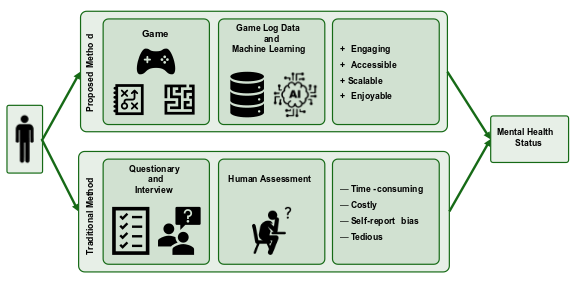From Play to Prediction: Assessing Depression and Anxiety in Players Behavior with Machine Learning Models
DOI:
https://doi.org/10.17083/ijsg.v12i1.897Keywords:
Serious Games, Mental Health, Machine Learning, AI in Psychology, Depression and Anxiety, Log Data Analysis , Game-based Assessment, Human-computer InteractionAbstract
In today's society, depression and anxiety pose significant challenges for individuals across various age groups, emphasizing the need for timely identification to facilitate effective treatment and prevent future complications. However, current methods of assessing mental health often rely on self-reporting, which can be biased and tedious. This paper explores the potential of utilizing artificial intelligence for continuous, unobtrusive monitoring of mental well-being through the analysis of gameplay log data in a multi-genre game involving 64 participants with Machine learning algorithms, specifically the NuSVC model, achieved 93.75% accuracy, 94.44% precision, 93.75% recall, and a 93.72% F1-score for identifying depression, while the GBM classifier attained 93.75% accuracy, 95.45% precision, 93.75% recall, and a 91.67% F1-score for detecting anxiety. These findings highlight the potential of using game-based behavioral data as a potential indicator of mental health status and offering an innovative approach for diagnosis that reduces the burden on healthcare systems and makes mental health support more accessible to those reluctant to seek help through conventional means.

Downloads
Published
Issue
Section
License
Copyright (c) 2025 Soroush Elyasi, Arya VarastehNezhad, Fattaneh Taghiyareh

This work is licensed under a Creative Commons Attribution-NonCommercial-NoDerivatives 4.0 International License.
IJSG copyright information is provided here.